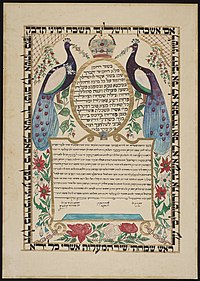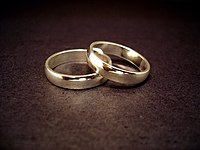




AJewish wedding is a wedding ceremony that follows Jewish laws and traditions.
While wedding ceremonies vary, common features of a Jewish wedding include a ketubah (marriage contract) which is signed by two witnesses, a chuppah (orhuppah; wedding canopy), a ring owned by the groom that is given to the bride under the canopy and the breaking of a plate.
Technically, the Jewish wedding process has two distinct stages:[1] kiddushin (sanctification or dedication, also called erusin, betrothal in Hebrew) and nissuin (marriage), when the couple start their life together. The first stage prohibits the woman to all other men, requiring a get (religious divorce) to dissolve, and the final stage permits the couple to each other. The ceremony that accomplishes nisuin is known as chuppah.[2]
Today, erusin/kiddushin occurs when the groom gives the bride a ring or other object of value with the intent of creating a marriage. There are differing opinions as to which part of the ceremony constitutes nissuin/chuppah; they include standing under the canopy - itself called a chuppah - and being alone together in a room (yichud).[2] While historically these two events could take place as much as a year apart,[3] they are now commonly combined into one ceremony.[2]
The examples and perspective in this section deal primarily with the United States and do not represent a worldwide view of the subject. You may improve this section, discuss the issue on the talk page, or create a new section, as appropriate. (December 2018) (Learn how and when to remove this message)
|
Before the wedding ceremony, the groom agrees to be bound by the terms of the ketubah (marriage contract) in the presence of two witnesses, whereupon the witnesses sign the ketubah.[4] The ketubah details the obligations of the groom to the bride, among which are food, clothing, and marital relations. This document has the standing of a legally binding agreement, though it may be hard to collect these amounts in a US court house.[5] It is often written as an illuminated manuscript that is framed and displayed in their home.[6] Under the chuppah, it is traditional to read the signed ketubah aloud, usually in the Aramaic original, but sometimes in translation. Traditionally, this is done to separate the two basic parts of the wedding.[7] Non-Orthodox Jewish couples may opt for a bilingual ketubah, or for a shortened version to be read out.
A traditional Jewish wedding ceremony takes place under a chuppah (wedding canopy), symbolizing the new home being built by the couple when they become husband and wife.[8][9]

Prior to the ceremony, Ashkenazi Jews have a custom to cover the face of the bride (usually with a veil), and a prayer is often said for her based on the words spoken to Rebecca in Genesis 24:60.[10] The veiling ritual is known in Yiddishasbadeken. Various reasons are given for the veil and the ceremony, a commonly accepted reason is that it reminds the Jewish people of how Jacob was tricked by Laban into marrying Leah before Rachel, as her face was covered by her veil (see Vayetze).[11] Another reasoning is that Rebecca is said to have veiled herself when approached by Isaac, who would become her husband.[12] Sephardi Jews do not perform this ceremony. Additionally, the veil emphasizes that the groom is not solely interested in the bride's external beauty, which fades with time; but rather in her inner beauty which she will never lose.[13]
In many Orthodox Jewish communities, the bride is escorted to the chuppah by both mothers, and the groom is escorted by both fathers, known by Ashkenazi Jews as unterfirers (Yiddish: "Ones who lead under").[14]





The bride traditionally walks around the groom three or seven times when she arrives at the chuppah. This may derive from Jeremiah 31:22, "A woman shall surround a man". The three circuits may represent the three virtues of marriage: righteousness, justice and loving kindness (see Hosea 2:19). Seven circuits derives from the Biblical concept that seven denotes perfection or completeness.[14] Sephardic Jews do not perform this ceremony.[15]
In traditional weddings, two blessings are recited before the betrothal; a blessing over wine, and the betrothal blessing, which is specified in the Talmud.[16] The wine is then tasted by the couple.[17]
The groom gives the bride a ring, traditionally a plain wedding band,[18] and recites the declaration: Behold, you are consecrated to me with this ring according to the law of Moses and Israel. The groom places the ring on the bride's right index finger. According to traditional Jewish law, two valid witnesses must see him place the ring.[17]
During some egalitarian weddings, the bride will also present a ring to the groom,[19][20] often with a quote from the Song of Songs: "Ani l'dodi, ve dodi li" (I am my beloved's and my beloved is mine), which may also be inscribed on the ring itself.[21][22] This ring is sometimes presented outside the chuppah to avoid conflicts with Jewish law.[23][24][25]
The Sheva Brachot or seven blessings are recited by the hazzanorrabbi, or by select guests who are called up individually. Being called upon to recite one of the seven blessings is considered an honour. The groom is given the cup of wine to drink from after the seven blessings. The bride also drinks the wine. In some traditions, the cup will be held to the lips of the groom by his new father-in-law and to the lips of the bride by her new mother-in-law.[26] Traditions vary as to whether additional songs are sung before the seven blessings.
After the bride has been given the ring, or at the end of the ceremony (depending on local custom), the groom breaks a glass, crushing it with his right foot, and the guests shout: "Mazel Tov!" (Hebrew: "congratulations"). At some contemporary weddings, a lightbulb may be substituted because it is thinner and more easily broken, and it makes a louder popping sound.[27]
The origin of this custom is unknown, although many reasons have been given. The primary reason is that joy must always be tempered.[28] This is based on two accounts in the Talmud of rabbis who, upon seeing that their son's wedding celebration was getting out of hand, broke a vessel – in the second case a glass – to calm things down. Another explanation is that it is a reminder that despite the joy, Jews still mourn the destruction of the Temple in Jerusalem. Because of this, some recite the verses "If I forget thee / O Jerusalem..." (Ps. 137:5) at this point.[18] Many other reasons have been given by traditional authorities.[28]
Former Sephardic Chief Rabbi of Israel Ovadia Yosef has strongly criticized the way this custom is sometimes carried out, arguing that "Many unknowledgeable people fill their mouths with laughter during the breaking of the glass, shouting 'mazel tov' and turning a beautiful custom meant to express our sorrow" over Jerusalem's destruction "into an opportunity for lightheadedness."[29]
Reform Judaism has a new custom where brides and grooms break the wine glass together.
Yichud (togetherness or seclusion) refers to the Ashkenazi practice of leaving the bride and groom alone for 10–20 minutes after the wedding ceremony. The couple retreats to a private room. Yichud can take place anywhere, from a rabbi's study to a synagogue classroom.[30] The reason for yichud is that according to several authorities, standing under the canopy alone does not constitute chuppah, and seclusion is necessary to complete the wedding ceremony.[2] However, Sephardic Jews do not have this custom, as they consider it a davar mechoar (repugnant thing), compromising the couple's modesty.[31]
In Yemen, the Jewish practice was not for the groom and his bride to be secluded in a canopy (chuppah), as is widely practiced today in Jewish weddings, but rather in a bridal chamber that was, in effect, a highly decorated room in the house of the groom. This room was traditionally decorated with large hanging sheets of colored, patterned cloth, replete with wall cushions and short-length mattresses for reclining.[32] Their marriage is consummated when they have been left together alone in this room. This ancient practice finds expression in the writings of Isaac ben Abba Mari (c. 1122 – c. 1193), author of Sefer ha-'Ittur,[33] concerning the Benediction of the Bridegroom: "Now the chuppah is when her father delivers her onto her husband, bringing her into that house wherein is some new innovation, such as the sheets… surrounding the walls, etc. For we recite in the Jerusalem Talmud, Sotah 46a (Sotah 9:15), 'Those bridal chambers, (chuppoth hathanim), they hang within them patterned sheets and gold-embroidered ribbons, and more.
Dancing is a major feature of Jewish weddings. It is customary for the guests to dance in front of the seated couple and entertain them.[34] Traditional Ashkenazi dances include:
After the meal, Birkat Hamazon (Grace after meals) is recited, followed by sheva brachot. At a wedding banquet, the wording of the blessings preceding Birkat Hamazon is slightly different from the everyday version.[36] Prayer booklets called benchers, may be handed out to guests. After the prayers, the blessing over the wine is recited, with two glasses of wine poured together into a third, symbolising the creation of a new life together.[34]
In present times, Jewish rabbinical bodies have developed Jewish prenuptial agreements designed to prevent the husband from withholding a get from his wife, should she want a divorce. Such documents have been developed and widely used in the United States, Israel, the United Kingdom and other places. However, this approach has not been universally accepted, particularly by the Orthodox.[37]
Conservative Judaism developed the Lieberman clause in order to prevent husbands from refusing to give their wives a get. To do this, the ketubah has built in provisions; so, if predetermined circumstances occur, the divorce goes into effect immediately.[38]
Weddings should not be performed on Shabbat or on Jewish holidays, including Chol HaMoed. The period of the Counting of the Omer and the The Three Weeks are also prohibited, although customs vary regarding part of these periods. Some months and days are considered more or less auspicious.[39]
|
Jewish life
| ||
|---|---|---|
| Birth and infancy |
| |
| Coming of age |
| |
| Daily life |
| |
| Marriage |
| |
| Religious practice |
| |
| Religious items |
| |
| Death |
| |
|
Marital life in Judaism
| ||
|---|---|---|
| Jewish wedding |
| |
| Prohibitions and Halakhot |
| |
| Women forbidden to their husbands |
| |
| Purity of a woman to her husband |
| |
| Jewish divorce |
| |